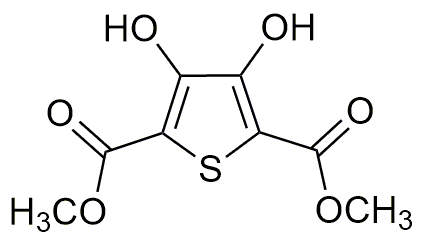Dimethyl 3,4-dihydroxy-2,5-thiophenedicarboxylate is widely utilized in research focused on:
- Pharmaceutical Development: This compound serves as a key intermediate in the synthesis of various pharmaceutical agents, particularly those targeting oxidative stress and inflammation.
- Organic Electronics: It is employed in the production of organic semiconductors, enhancing the performance of electronic devices such as organic light-emitting diodes (OLEDs) and solar cells.
- Agrochemicals: The compound is used in the formulation of pesticides and herbicides, providing effective solutions for crop protection while minimizing environmental impact.
- Research in Material Science: It plays a role in developing advanced materials, including conductive polymers and coatings, which are essential for various industrial applications.
- Biochemical Research: This chemical is utilized in studies related to enzyme inhibition and metabolic pathways, offering insights into potential therapeutic targets for diseases.
General Information
Properties
Safety and Regulations
Applications
Dimethyl 3,4-dihydroxy-2,5-thiophenedicarboxylate is widely utilized in research focused on:
- Pharmaceutical Development: This compound serves as a key intermediate in the synthesis of various pharmaceutical agents, particularly those targeting oxidative stress and inflammation.
- Organic Electronics: It is employed in the production of organic semiconductors, enhancing the performance of electronic devices such as organic light-emitting diodes (OLEDs) and solar cells.
- Agrochemicals: The compound is used in the formulation of pesticides and herbicides, providing effective solutions for crop protection while minimizing environmental impact.
- Research in Material Science: It plays a role in developing advanced materials, including conductive polymers and coatings, which are essential for various industrial applications.
- Biochemical Research: This chemical is utilized in studies related to enzyme inhibition and metabolic pathways, offering insights into potential therapeutic targets for diseases.
Documents
Safety Data Sheets (SDS)
The SDS provides comprehensive safety information on handling, storage, and disposal of the product.
Product Specification (PS)
The PS provides a comprehensive breakdown of the product’s properties, including chemical composition, physical state, purity, and storage requirements. It also details acceptable quality ranges and the product's intended applications.
Certificates of Analysis (COA)
Search for Certificates of Analysis (COA) by entering the products Lot Number. Lot and Batch Numbers can be found on a product’s label following the words ‘Lot’ or ‘Batch’.
*Catalog Number
*Lot Number
Certificates Of Origin (COO)
This COO confirms the country where the product was manufactured, and also details the materials and components used in it and whether it is derived from natural, synthetic, or other specific sources. This certificate may be required for customs, trade, and regulatory compliance.
*Catalog Number
*Lot Number
Safety Data Sheets (SDS)
The SDS provides comprehensive safety information on handling, storage, and disposal of the product.
DownloadProduct Specification (PS)
The PS provides a comprehensive breakdown of the product’s properties, including chemical composition, physical state, purity, and storage requirements. It also details acceptable quality ranges and the product's intended applications.
DownloadCertificates of Analysis (COA)
Search for Certificates of Analysis (COA) by entering the products Lot Number. Lot and Batch Numbers can be found on a product’s label following the words ‘Lot’ or ‘Batch’.
*Catalog Number
*Lot Number
Certificates Of Origin (COO)
This COO confirms the country where the product was manufactured, and also details the materials and components used in it and whether it is derived from natural, synthetic, or other specific sources. This certificate may be required for customs, trade, and regulatory compliance.


